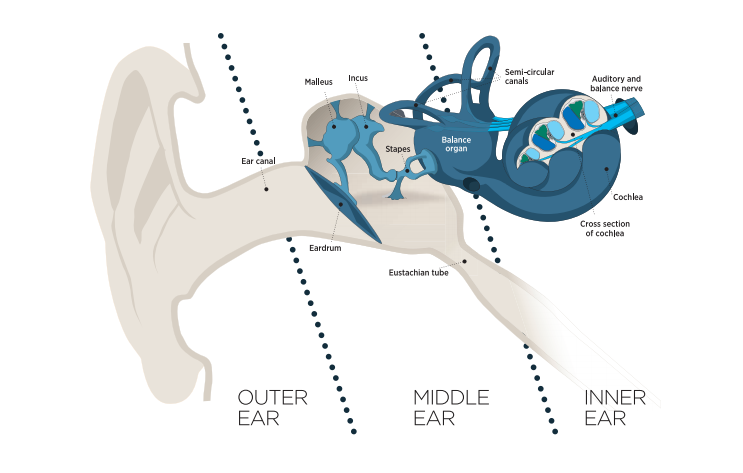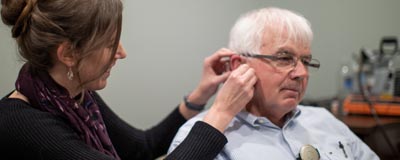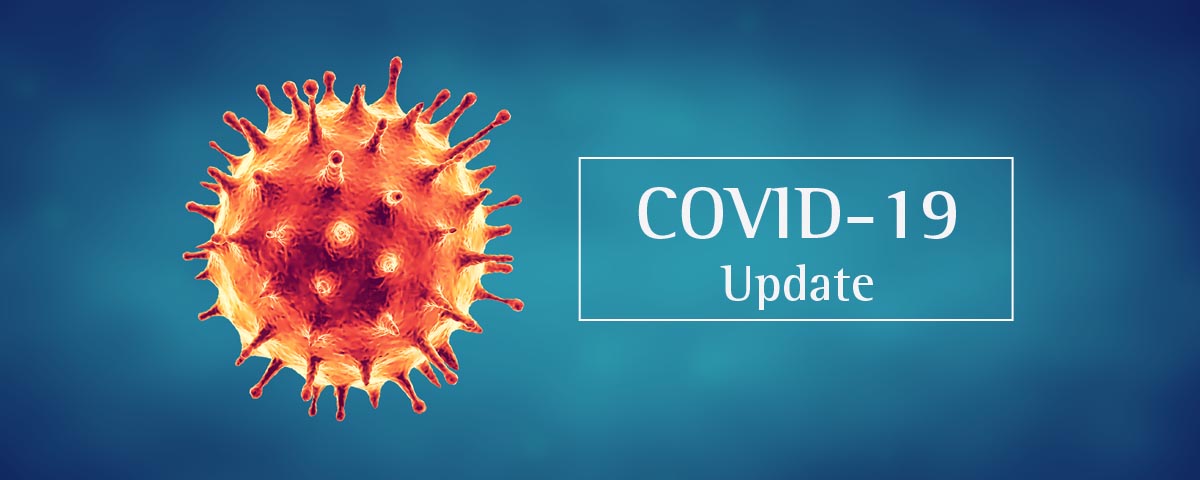What is Presbycusis?
Presbycusis is a pattern of hearing loss found in older adults, also known as age related hearing loss. The natural degeneration of the hearing system as we age is common. A typical onset of presbycusis can go unnoticed for 2-5 years. The slow progression of hearing loss makes it difficult to notice on a day to day basis. Untreated hearing losses can have multiple impacts on communication, quality of life and healthy aging.
The inner ear houses the cochlea, which is a snail shaped organ. Within the cochlea are small hair fibers responsible for transmitting sound waves and vibrations into our central auditory cortex for the brain to decode and process. We are born with thousands of inner hair cells (roughly 3,500) and the outer hair cells, (around 12,000). For humans, once damaged, these hair cells do not regrow or repair themselves. In cases of presbycusis and most sensorineural hearing losses, there is damage to the hair cells. The standard pattern we see in cases of presbycusis is damage to the hair cells at the base of the cochlea which associates with high pitch sounds. Individuals with a progressive hearing loss will slowly lose the ability to hear high pitch sounds. This includes many sounds such as alarms, doorbells, ringtones, bird song and certain parts of speech.
Causes of Hair Cell Damage
Normal Wear and Tear: The aging process takes a toll on the hearing system just like all other cells in the
body. Over time, the function of the cochlear hair cells tends to diminish.
Noise Exposure: Whether it is loud music, industrial noise, a cheering sports stadium, an ambulance siren
or fire alarm, the world is a noisy environment. The extent to which noise damages hearing is directly
related to the intensity of the sound and the duration of that noise. Here is a list of some common
sources of noise exposure and the safe duration without using hearing protection.
Restaurant – 85dB – 8 hours
Band Rehearsal – 90dB – 2 hours
Power Tools – 100dB – 15 minutes
iPod at high volume – 105dB – 5 minutes
Sports Stadium – 108dB – 3 minutes
Chainsaw – 110dB – 1.5 minutes
Rock Concert – 110dB – 1.5 minutes
Ambulance Siren – 120dB – 9 seconds
Firearms – 140-160dB – immediate damage possible
Genetics: Some families are more predisposed to hearing loss.
Medications: There is a rather large list of ototoxic drugs that are currently or have previously been on
the market. These include certain antibiotic families and chemotherapy drugs. A dosage of certain drugs
can cause irreparable damage to the inner hair cells.
Illness: Certain diseases target and damage the inner ear. Meningitis is one such example, which can lead
to a severe to profound hearing loss.
Poor Diet: This one may shock you, but there is some new evidence suggesting that eating a poor diet has
been linked to hearing loss. This is likely due to the hair cells not receiving proper nourishment, and thus
developing premature deterioration.
Why does it go unnoticed?
While sounds are still heard and perceived at a normal volume, there are certain sounds that are missed. In conversation, the use of lip reading, body language, and context can help to understand speech. When a person has a hearing loss, listening in noise is especially difficult. Many consonants contain high frequency sounds and are higher in pitch than their vowel counterparts. When background noise is present, consonant confusion can easily give rise to communication confusion and misunderstanding.
For example, consonant sounds /t/, /k/, /p/, /f/, /s/, and /sh/ may be indistinguishable from one another when hearing with background noise and/or distortions of a high frequency hearing loss. This means that without sufficient context, words like taught, caught, pot, fought, sought, or shot could all get easily confused and have a considerable impact on communication.
E.G. The girls ______ over the last piece of candy.
The context of this sentence would allow the individual with hearing loss to assume the missed word was fought.
Impact on Speech Understanding
High frequency sounds of speech are often lost or muffled while low frequency sounds remain full and clear. Common complaints from an individual with hearing loss are that others are mumbling, when really their clarity of speech understanding has diminished since they are missing a large portion of important speech signals. This loss of clarity extends to audible signals such as TV, radio, and telephone calls. You can read more about hearing loss and difficulty using the telephone here on another one of our blog posts.
Hearing aids and communication strategies are great tools to help with communication and speech understanding. We recommend annual hearing test to monitor hearing health. Early detection of presbycusis prevents sensory deprivation and improves overall adaptation, acclimatization and performance with hearing aids or other assistive listening devices.








